The Razer Edge Review
by Vivek Gowri on March 28, 2013 11:00 AM EST- Posted in
- Tablets
- Mobile
- Razer
- Razer Edge
Performance
Now for the good parts. We’re actually pretty familiar with the computing platform behind the Edge. The ultra-low voltage IVB parts are commonly found in ultrabooks and are some of the AT mobile team’s favorite mobile processors right now. I’m not the only one, Dustin just rhapsodized about the ULV Core i5s in his review of the updated Dell XPS 13 last week. The usable performance and reasonable power draw on offer are just that fantastic, and these CPUs really represent the sweet spot of the market right now. I’m not sure that the additional CPU headroom of the i7s is really necessary or worth the additional cost; the 100-200MHz clock speed bumps are pretty incremental. The only really compelling thing about the i7 SKUs is their ability to hit 3.0-3.1GHz on Turbo, a solid 400MHz higher than the corresponding i5 parts.
The other thing is that I’m seeing a lot of cases where there will be two SKUs on offer – one with an i5, 4GB RAM, and a 64GB/128GB SSD, and then a high end one that offers spec bumps across the board – i7, 8GB, and 128GB/256GB. We’re moving away from the early 2000s Dell/HP/Gateway-era of pick your component computing, so the decision between i5 and i7 chips might actually be hinge on the rest of the package, as is the case with the Edge.
Anyways, that’s diverging a bit. We’re very familiar with both of the CPUs used by the Edge from various ultrabooks; in particular, the i5-3317U is the heart of my trusty ASUS Zenbook Prime and I just recently looked at the i7-3517U in my review of the Vizio CT15. The i7-3517U has a base clock speed of 1.9GHz and a max turbo of 3.0GHz, along with HD 4000 onboard graphics (350MHz base clock, 1.15GHz max). It performs roughly where we’d expect, and I’d also like to highlight the relative lack of differences between the i5 and i7 ULV SKUs here.
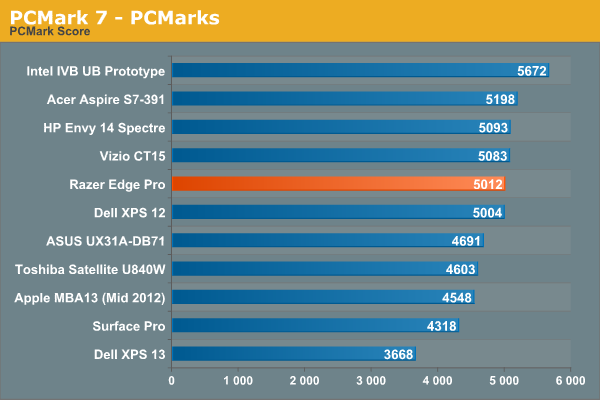
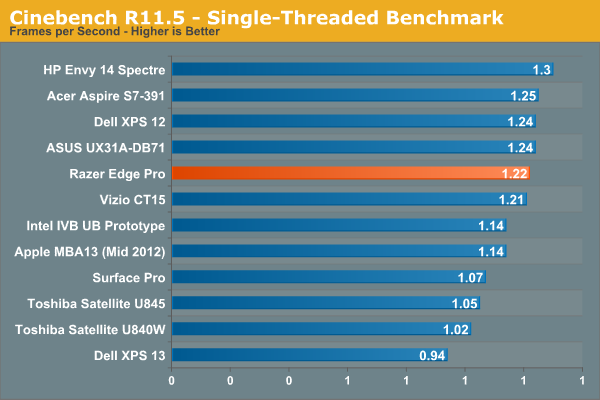
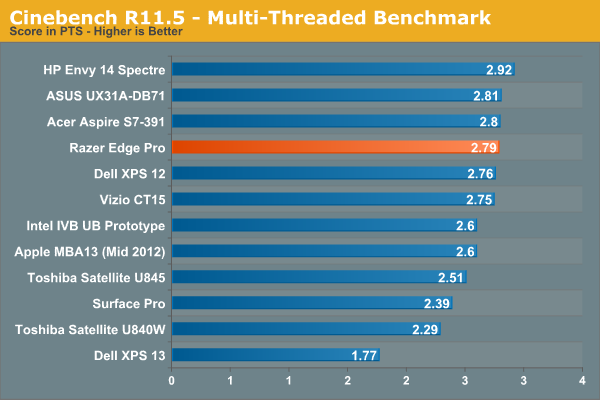
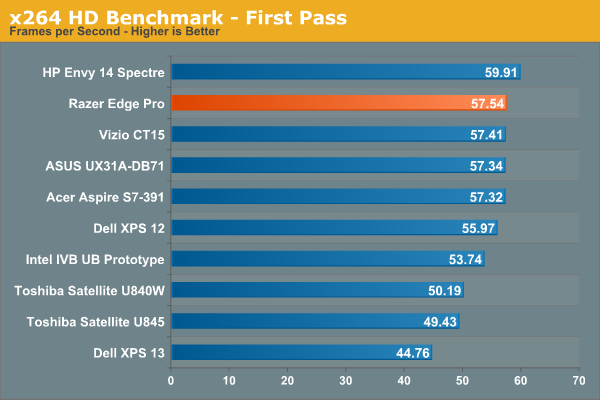
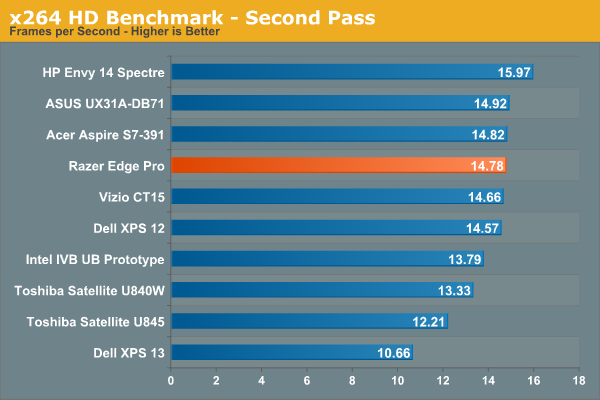

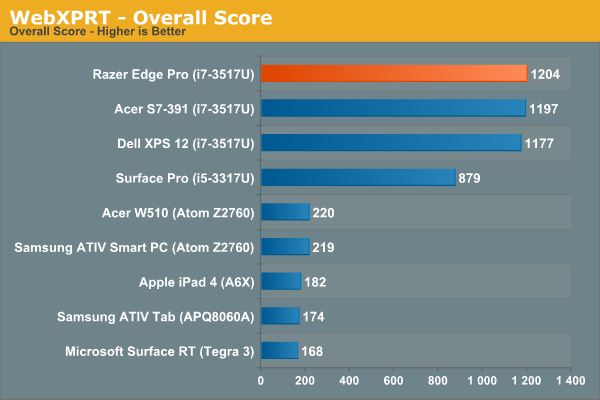
Graphics Performance
Nvidia’s mobile GPU heirarchy can get very, very convoluted, particularly at the low end, with a mix of new, old, and gap-bridging parts all under the same name. As such, there are many variants of GT 640M and GT 640M LE, with a mix of SKUs spanning the 28nm Kepler, 40nm Fermi, and 28nm die-shrunken Fermi cores. An interesting and related side-note: a few days ago, Anand asked the mobile team if we had seen any Kepler-based GT 630M notebooks. It took a bit of searching, but eventually it was determined that none of the GT 630M SKUs are actually Kepler based, only 28nm and 40nm variants of the Fermi core. When the lineups are so jumbled that even we can’t keep track of them, there’s something wrong. Why are some GT 640Ms so slow, while others are nearly equal to the DDR3 GT 650M? Why are there still 40nm GeForce 600M parts? I wish Nvidia could simplify and streamline their mobile GPU lineup, it’d make our lives easier as well as being a lot more transparent for consumers.
The GT 640M LE in the Edge is thankfully a Kepler part, so a 28nm GK107 core with 384 cores, 16 ROPs, and 32 TMUs, just like all Keplers from the GTX 660M on down. This is the absolute bottom of the range, so it has the slowest memory configuration (900MHz DDR3) and a 500MHz core clock, with boost up to 570MHz. The next big hardware jump comes with GDDR5 VRAM in the GT 650M, and a combination of clock speeds and GPU boost make up the differences between SKUs.
The 1366x768 panel comes into play here – Kepler, even at 500MHz, is more than capable of pushing 768p displays at high settings in modern games. High quality textures really start to tax the slower memory in the low-end Kepler cards as you increase resolution, so even with higher clock speeds, 1080p gaming will be non-ideal at best and downright bad at worst. Don’t expect much to be playable, as even the DDR3 variant of the GT 650M basically failed the 1080p portion of our gaming tests. The GDDR5 GT 650M and the GTX 660M (which comes in GDDR5 form only) do better here, but there’s a pretty substantial gap between those two chips and the rest of the GK107 mobile parts at 1080p.
We haven’t yet finalized our 2013 Gaming test suite, so I just ran our 2012 test suite. I did almost all of my testing on the road, sans access to 1080p displays, so I only have 1366x768 gaming results (that’s our value gaming suite, which runs medium detail settings at 768p). I also ran at high detail settings, to see what kind of differences there would be. Once our new suite is finalized, I’ll update with results at 1600x900 and 1080p.
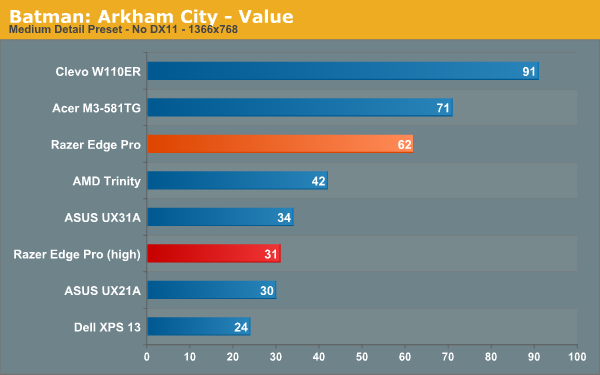
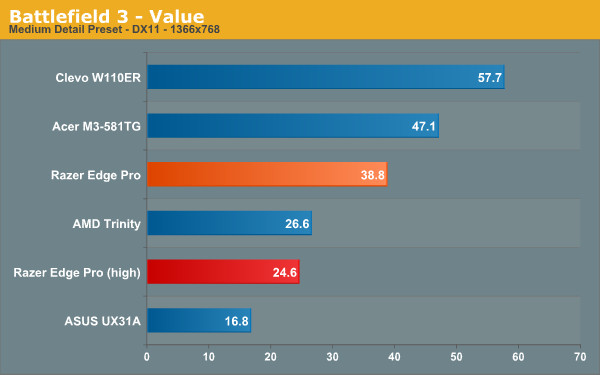
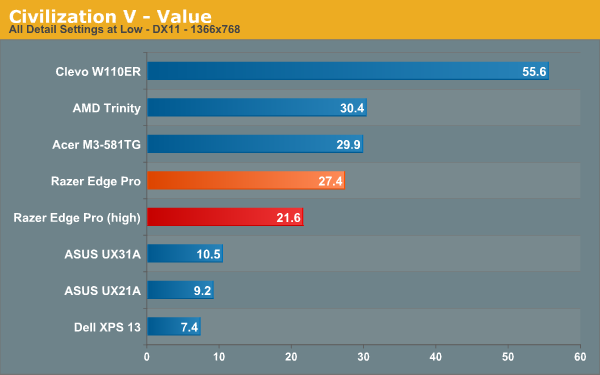
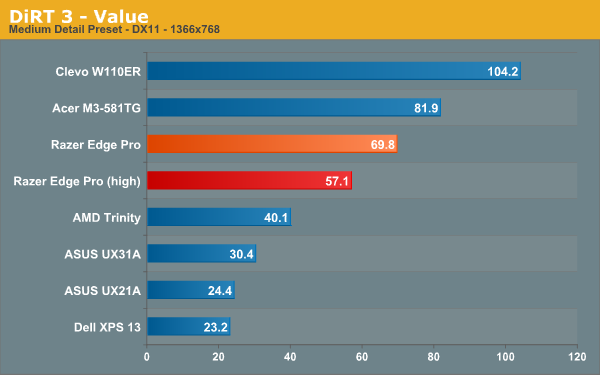

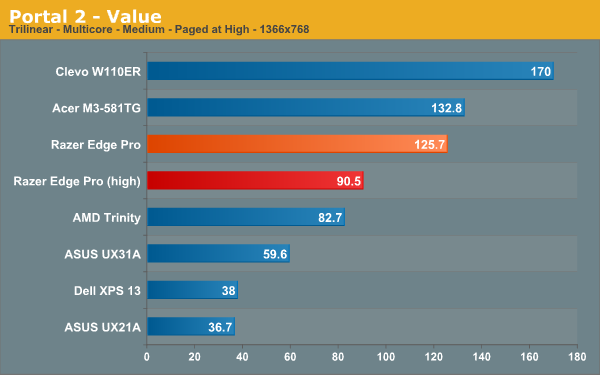
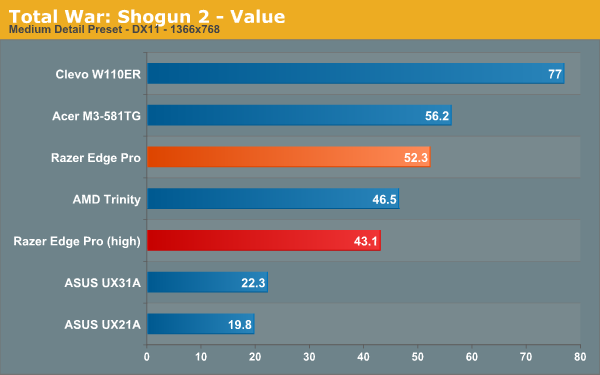
The Edge does pretty well, honestly – Kepler is a great mobile GPU, even clocked so low. At high settings, almost everything was playable, except for Battlefield 3 and Civ 5. I think Civ 5 is CPU limited on the Edge, while BF3 is one of the more strenuous games we test, so both of those were expected. Lower the settings to medium, and pretty much everything is playable.
The higher clock speeds of the GT 650M (DDR3) in the Clevo W110ER really make themselves felt, with substantially better gaming performance than the Edge throughout our benchmark suite. For a comparison with Surface Pro and the other IVB tablets, look at the ASUS Zenbook Primes - the UX31A with the 1.15GHz HD 4000 (i7-3517U) and the UX21A with the same HD 4000 clocked at 1.05GHz (i5-3317U). There's a small performance delta between the two due to the maximum frequency difference, but either way, HD 4000 seriously struggles to be playable in most of our benchmarks unless you lower either the resolution or detail settings. Again, Kepler at 500MHz is still a pretty capable card at 1366x768, so concern over frame rates is probably a moot one unless you’re gaming on an external display.










89 Comments
View All Comments
HisDivineOrder - Thursday, March 28, 2013 - link
If you were told that the spec is TN panels and you were given an IPS, then that means you were given a cherry picked unit and many of the launch units will include a TN panel and still be "up to spec."Whoops.
Also, I think it's pretty short sighted to say, "Well, 1366x768 is fine because gaming is going to be bad on a 1080p panel with that GPU." First, not every game is Crysis 3. Second, not everyone is going to want a decent PC-based tablet just to game. Some of them are in fact going to watch movies and/or web browse from time to time and having a high resolution panel would benefit them.
Perhaps Razer should have spec'ed a 2560x1440 panel to give the best of both worlds. Excellent with all content except games and a great way to down-rez to 1280x720 for high end gaming.
Considering the high cost of this thing (including one of those peripherals in your purchase price is a necessity), I think a high res panel is the least they could have done.
Anyway, good review except for you're constant apologies for Razer's mistakes. Also, I can't help feeling like this device REALLY reminds me of the first Razer Blade. The one that came out just before Ivy Bridge and sucked, only to be replaced in a few months time by a version that included IB, better power per watt, better everything, and a slightly lower price.
With Haswell incoming, buying one of these based on IB is downright wasteful since anyone who would want this will want that, too. Might as well wait.
Especially when the keyboard add-on isn't even ready for primetime.
VivekGowri - Friday, March 29, 2013 - link
Pre-launch, I was told TN, but that was apparently a mistake - all specsheets and units (preproduction as well as final production) I have encountered have been IPS. The production version has always been IPS, there's been nothing to indicate that mine was a cherry picked unit.royalcrown - Thursday, March 28, 2013 - link
Everyone is free to like what they will, here is my 2 cents on this thing:1. Ugly as hell
2. Pretty fat and bulky
3. Waay overpriced
Really, for what this thing costs base price, you can go buy a laptop that has all the same features or more, is just about the same thickness, already has all the "optional" ports, charger and other crap, more storage. That's before the overprived accessories.
For all the people that think, "But I can haz buttunz own itz." just add a ps3 controller to a laptop or use motionjoys PS3 controller driver and you have the same or better.
coolhardware - Thursday, March 28, 2013 - link
I'm not quite sure why so many people are hating on the Razer Edge and Vivek's review.He liked the machine and had a lot of fun playing games on it, he addresses the weaknesses and the strengths. He came to a conclusion and it is not an absurd one.
The tech industry needs visionaries and companies that release bleeding edge products. Not every original release can be as polished as we would like, I would argue that the opposite is true... most initial genre creating products have some pretty rough edges!
Kudos to Razer for having the balls to produce something like this: a tablet that can play PC games (without having to stream them from somewhere else).
Kudos to Vivek for taking the time to review and benchmark it so we can read about if for free and come to our own conclusion about purchasing it or not.
Now, what I would like to know a bit more about:
+can it easily be taken apart? (b/c I would like to know about upgrading the SSD)
+what is the warranty?
+what interface does the dock use (like what bandwidth does it have and what does the connector look like) [they mention that they didn't put USB3 on the dock there b/c not enough bandwidth, and that surprised me...]
Anyhoo, thanks for the review Vivek, I appreciate it!!!
bountygiver - Thursday, March 28, 2013 - link
it's a tablet, upgrading yourself is obviously not going to be easy, the question is only how hard?coolhardware - Friday, March 29, 2013 - link
Exactly.re we talking Surface Pro hard (i.e. sure it uses mSATA but you'll likely break it to upgrade it), or Dell XPS 10 (relatively easy). More info about tablet serviceability here: http://www.jdhodges.com/2013/03/tablet-teardowns/
althaz - Thursday, March 28, 2013 - link
I like this (A LOT), but the price point is too high. The $1499 bundle probably needs to be under $1000. The weight and thickness honestly don't bother me overly.Wolfpup - Thursday, March 28, 2013 - link
Cool that they actually pretty much pulled this off. I'd loooooove to have one, but realistically the money is better spent towards a normal, more powerful notebook (just got an M17x-R4 with a GTX 680).I wish that you got the features of the HDMI dock (either through the dock or built in) plus the second battery, plus the controller dock all included at any of the price points...I'd feel better about that price-wise. Interesting how it might handle games that really need a mouse and keyboard too...and yeah, it ought to have first party controller-as-mouse support, considering.
Darbyothrill - Thursday, March 28, 2013 - link
You would think that they would have wanted to wait for Haswell, considering Intel's claims that the GPU competes with the 650m.Jumangi - Thursday, March 28, 2013 - link
The Vita can't sell at $250 but a heavy $1000+ tablet based around gaming will? How does this stuff get past being laughed at during the boardroom meeting and get actually made?